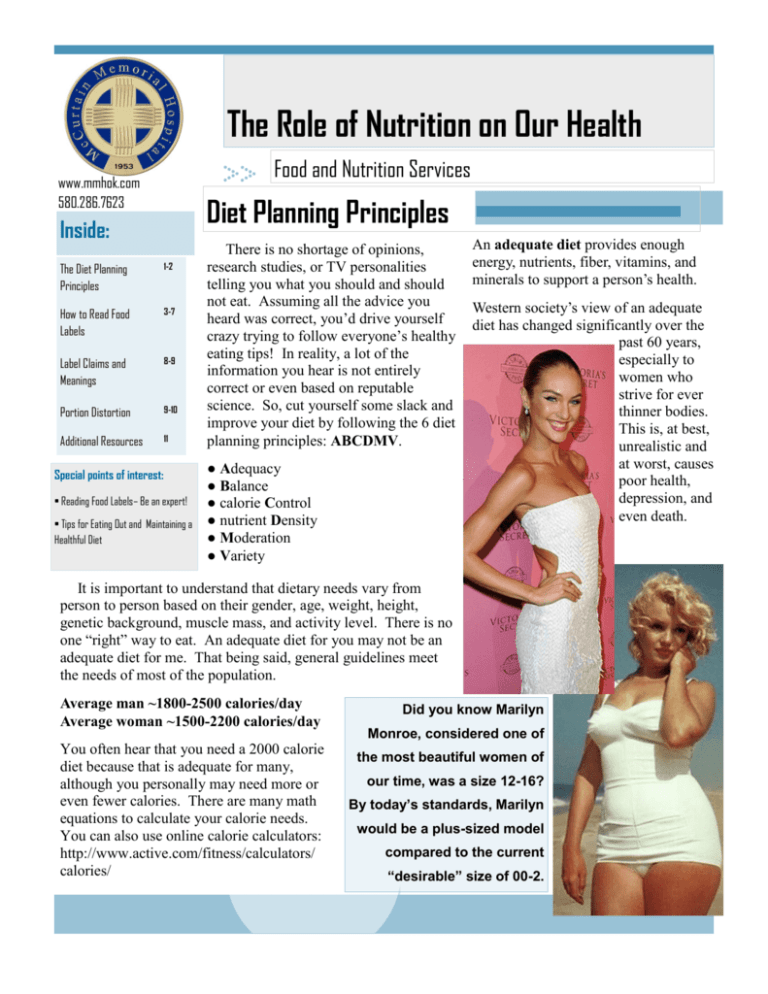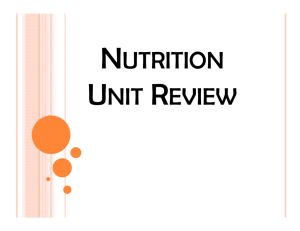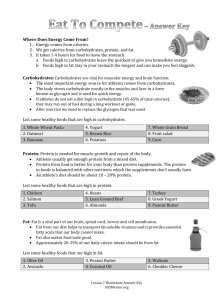Here - McCurtain Memorial Hospital
advertisement

The Role of Nutrition on Our Health Food and Nutrition Services www.mmhok.com 580.286.7623 Diet Planning Principles Inside: The Diet Planning Principles 1-2 How to Read Food Labels 3-7 Label Claims and Meanings 8-9 Portion Distortion 9-10 Additional Resources 11 Special points of interest: • Reading Food Labels– Be an expert! • Tips for Eating Out and Maintaining a Healthful Diet There is no shortage of opinions, research studies, or TV personalities telling you what you should and should not eat. Assuming all the advice you heard was correct, you’d drive yourself crazy trying to follow everyone’s healthy eating tips! In reality, a lot of the information you hear is not entirely correct or even based on reputable science. So, cut yourself some slack and improve your diet by following the 6 diet planning principles: ABCDMV. ● Adequacy ● Balance ● calorie Control ● nutrient Density ● Moderation ● Variety An adequate diet provides enough energy, nutrients, fiber, vitamins, and minerals to support a person’s health. Western society’s view of an adequate diet has changed significantly over the past 60 years, especially to women who strive for ever thinner bodies. This is, at best, unrealistic and at worst, causes poor health, depression, and even death. It is important to understand that dietary needs vary from person to person based on their gender, age, weight, height, genetic background, muscle mass, and activity level. There is no one “right” way to eat. An adequate diet for you may not be an adequate diet for me. That being said, general guidelines meet the needs of most of the population. Average man ~1800-2500 calories/day Average woman ~1500-2200 calories/day You often hear that you need a 2000 calorie diet because that is adequate for many, although you personally may need more or even fewer calories. There are many math equations to calculate your calorie needs. You can also use online calorie calculators: http://www.active.com/fitness/calculators/ calories/ Did you know Marilyn Monroe, considered one of the most beautiful women of our time, was a size 12-16? By today’s standards, Marilyn would be a plus-sized model compared to the current “desirable” size of 00-2. The Role of Nutrition on Our Health Page 2 Diet Planning Principles A balanced diet contains the right combinations of foods to provide the proper balance of nutrients. Balancing intake from each of the food groups (grains, fruits, vegetables, meat, and dairy) will help ensure a healthy general diet. What are Nutrients? Eating and nutrition is very personal. Many things affect a person’s food choices. Personal preference or taste is the top reason people choose the foods they do. Habit, ethnic heritage/tradition, social interaction, food availability and cost, ease of preparation, and how a person feels about themselves can all influence what someone eats. No matter what your reasons are for your personal food choices, it is essential that your general everyday diet includes the proper balance of nutrients. Nutrients are the chemicals in food that are critical to human growth and function. Our bodies are in a constant state of change and nutrients support these changes. Think about the reasons you Carbohydrates, fats, proteins, vitamins, minerals, and fluid make up the six classes of nutrients. might be impacting your choose certain foods. Do you think those reasons health? Macronutrients are those nutrients required by the body in large amounts. They are measured in grams (g) or kilograms (kg) and provide energy/calories to the body. The three macronutrients are carbohydrates, fats, and proteins. A calorie controlled diet demonstrates an individual understands portion sizes and how energy needs may fluctuate from Micronutrients are required in smaller amounts and are measured in day to day depending on activity micrograms (µg) or milligrams (mg). Vitamins and minerals are very level. important, but they do not provide any energy/calories. A nutrient dense diet refers to food choices with a high nutrient content relative to the calories (energy) in those foods. It is getting the most “bang for your buck.” Three Oreo cookies and a bowl of fruit provide the same number of calories. However, most of the energy in Oreos come from refined carbohydrates (sugar) and fat whereas the energy in fruit comes from natural sugars. You also have the added nutrition of vitamins, minerals, fiber, and water. You get more “bang for your buck” with fruit as your snack! At the same time many Americans are constantly dieting to lose weight, they are also often unable to moderate their diet. This is why many professionals agree that obesity and the obsession with thinness are a related and dangerous combination. A healthful diet (rather than “going on a diet”) is one that is moderate to maintain a realistic weight range. It is difficult to moderate however, when “normal” portion sizes have become so skewed. 1950– Coca-Cola sold in 6.5 oz bottles Today– 64 oz “Big Gulp” Tenfold increase in “normal” portion size! YIKES! The Role of Nutrition on Our Health Page 3 Diet Planning Principles and Food Labels “Variety is the spice of life!” It is also an important diet planning principle. While it is all well and good to love apples and bananas, if you do not eat strawberries and oranges, you are missing out on valuable sources of nutrition! Vary your fruits, vegetables, and even meat options. Chicken breast everyday is not only boring, it really does not make for a well-rounded diet. Add fish, pork, and even lean cuts of beef for a better (and more interesting) general diet. Unfortunately, it is true that healthier food costs more. There are ways to stay within your budget and still purchase better items. The very first step is to learn to read food labels. Beginning in 1973, the Food and Drug Administration (FDA) required food labels on many products. Labeling rules and laws are still changing as we continue to learn more about food and health but some things are constant. A food label must contain 5 parts: ● Statement of identity ● Net contents ● Ingredient list ● Manufacturer’s information ● Nutrition facts panel Although some spices (like Mrs. Dash) include a Nutrition Facts Panel, manufacturers are not required to include one because servings of spices are very small and contain only trace amounts of their ingredients. It is up to the consumer to read the other parts of the label and ingredient list on things like spice blends to look for things like salt. Mrs. Dash is a salt-free spice blend in several flavors and is a more preferable choice than salt especially in people with heart conditions or high blood pressure. If you have kidney disease, talk to your doctor before using Mrs. Dash products as they contain potassium. The Role of Nutrition on Our Health Page 4 Nutrition Facts Panel The Nutrition Facts Panel is the most important part of a product label and, when read and used correctly, can help you make better food choices! To the right we have the facts for Macaroni and Cheese. There are 5 major parts. 1) The serving size and servings per container This is the critical part of a label to understand. In this example, a serving size is 3.5 ounces and there are 4 servings per container. In other words, we have 4 servings of mac and cheese that are 3.5 ounces each. Here is where food labels can get kind of tricky because the rest of the information pertains to only ONE serving (1 bowl of mac and cheese). 2) Calories and calories from fat per serving ONE bowl gives you 320 calories and 90 of those calories are from fat. 90 / 320= 28% of the calories come from fat. Now, that doesn’t sound too bad, right? But anyone with a teenager will tell you that their child can eat the ENTIRE box of mac and cheese at once! Quite often, the amount of food you consume does not match the manufacturer’s serving size printed on the box. You have to adjust the numbers based on what you actually eat! Eating the whole box of mac and cheese means eating all the servings in that container. 320 calories for one serving now becomes 1280 calories for all four servings! An average person needs about 2000 calories for the entire day and a whole box of mac and cheese gives over half of those calories but provides very little healthy nutrition in return as you will see from the rest of the label. 3) List of nutrients Total fat is the amount of fat in ONE serving. Indented underneath are the types of fats that make up total fat. - Saturated fat (a bad fat) is found in red meat, whole dairy products like milk, cheese, sour cream, ice cream, and butter. It can also be found in some plant-based cooking oils. - Trans fat (a bad fat) is found in fried foods, pre-packaged snacks, cakes/cookies/pies, and margarines. - Monounsaturated and Polyunsaturated fat (both good fats not listed on this particular label but account for a portion of the total fat). The Role of Nutrition on Our Health Page 5 Nutrition Facts Panel The list of nutrients continues with cholesterol, sodium, carbohydrates, fiber, sugars, protein, vitamins, and minerals. Because these measurements are in grams and milligrams, they usually have very little meaning to the average person. Not to worry, that’s where the fourth part of the panel can help. 4) % Daily Values This column describes how much one serving of food contributes to your total intake of a nutrient for that day. Labels are always based on a 2000 calorie diet unless otherwise specified. In your one bowl of mac and cheese, you get 15% of your entire day’s worth of fat. At first glance, maybe that isn’t too bad. But again, how much did you actually eat? If you ate the entire box or all 4 servings, you really got 60% of all the fat you need in a day! The % Daily Values column is useful in determining if a food is high or low in particular nutrients. ● less than 5% is considered low ● greater than 20% is considered high One serving of mac and cheese is low in Vitamin A and Vitamin C and high in sodium (salt) and almost high in saturated fat. Good Rules of Thumb for Label Reading Choose foods that have 3 grams or less of saturated fat per serving. Saturated fat is impossible to completely avoid because many foods that contain good fats also contain saturated fat. Avoid trans fat whenever possible. Compare similar product labels to find which one has less or no trans fat. Look for products low in (less than 5%) cholesterol. Pick items that have “no added salt” or are “lower sodium.” These foods often still have salt especially pre-packaged and convenience foods like boxed meals and canned soups and vegetables. Look for foods with 3 grams or higher in fiber. Total carbohydrates are different kinds of sugars. If you have Diabetes, you especially need to carefully monitor your carbohydrate intake. Sugars refers to natural sugars (like in fruits) and added sugars (like in kids’ breakfast cereals). It is important to understand that many foods have healthy natural sugars but we should try to avoid the added unnecessary sugars. The Role of Nutrition on Our Health Page 6 Nutrition Facts Panel 5) Footnote for Daily Values This is the final part of a panel on some labels. It contains general dietary advice for the typical consumer. The footnote shows just how much total fat, saturated fat, etc. you should consume in an entire day if you eat about 2000 calories or 2500 calories. You can keep track of these different nutrients by reading food labels and adding up what you eat in a day. Do your values equal the footnote recommendations? Reading Nutrition Labels– Expert Level! Food companies often don’t want you to notice the “bad” ingredients they put in their products. It is up to you to be an educated consumer! Trans fats are mostly manufactured fats that don’t occur very often in nature. In other words, the human body really isn’t designed to handle this kind of fat and it ends up harming our body in very scary ways. The difficulty for food companies is that trans fat makes everything taste so good and they want you to buy their yummy food. So, they often hide the true trans fat content of their product. Through a legal labeling loophole, manufacturers can actually claim no trans fat on their product and list 0 grams trans fat on the Nutrition Facts Panel when the item MAY actually have up to .49 grams of trans fat per serving. Since you are a savvy consumer, you can look at the ingredient list. If you see the words “partially hydrogenated” anywhere on the list, that product contains trans fat. Check your margarine labels and be sure to pick one that really doesn’t have trans fat! The Role of Nutrition on Our Health Page 7 Reading Nutrition Labels– Expert Level! Another thing some manufacturers do is give you multiple columns of information. In this example for Jiffy Corn Muffins, there is a column for “mix” and a column for “baked.” The “mix” column has the values if you were to just open up the box and eat the yellow powder! YUCK! This column contains worthless information and should be ignored completely. The “baked” column will be how you eat the product after adding an egg and milk so that should be the information you study. 1 baked muffin is a serving and there are 6 servings (6 muffins) per container. What else do you notice about this label? Is your muffin high (>20%) in anything? Is it low (<5%) in anything? The label says 0g trans fat. Is that the truth? What happens to your nutrition values if you add butter or margarine to your corn muffin? There’s a lot to consider when planning a healthy and well-balanced diet! Another good tip to picking better foods is to avoid the ones that you can’t determine how much of the food makes up a serving. This label says a serving size is 34grams. How many cookies is that? Don’t know? Put it back! The Role of Nutrition on Our Health Page 8 Nutrient Claims The FDA has an approved list of claims that may be present on packaging of qualifying products. These charts explain what those claims mean. Just because a label says the product is “low” or “reduced,” that doesn’t necessarily make it the healthier option. Fig Newton cookies are an excellent example. ● Low Fat Fig Newton 204 calories 0g fat ● Fig Newton 210 calories 4.5g fat Notice while the low fat cookies do have significantly less fat, the calories in both cookies are nearly identical. How can that be? Well, it’s simple. Fat tastes very good. Without the fat, food manufacturers have to put something in to make up for the lost flavor. In this case, they add extra sugar which is not at all healthy! The Role of Nutrition on Our Health Portion Distortion There is no standardized definition for a serving size of any food. What YOU view as a portion of a food is not necessarily my view… or the manufacturer’s view. Recommended serving sizes are often smaller than serving sizes on nutrition labels and smaller than the quantities Americans typically eat. Plus, many people eat far too few healthy foods like fruits, vegetables, whole grains, and low-fat dairy products. All of this adds up to one big problem. Page 9 The Role of Nutrition on Our Health Page 10 Tips for Eating Out and Maintaining a Healthful Diet Avoid breaded or fried foods—go for grilled, instead. Order salad dressing on the side and use the “fork method” of dipping your fork in once for each bite. Ask for steamed vegetables. Be sure to request no added butter, sauces, or salt! Instead of potatoes ask for vegetables or brown rice. Avoid cream sauces and order cheese sauces on the side (fork method!). Order half portions or appetizer sized portions as your main entrée. Split an order with a friend or request a to-go box and immediately put away half your portion. Don’t get soda or sweet tea refills Skip desert– have fresh fruit at home! Eat less by eating more fruits and vegetables which have high water and fiber content which will help you stay full. Lean proteins like chicken and fish will also help you feel satisfied. The Role of Nutrition on Our Health 1301 E Lincoln Rd Idabel, OK 74745 Phone: 580.286.7623 Page 11 McCurtain Memorial Hospital was originally established in 1954 and exists to provide excellence in healthcare. Our vision is to be the healthcare provider of choice in our region. We are proud to be working for a healthier community. We understand that actions speak louder than words and that is why we take our mission and vision seriously. We are always striving to improve our services and we value your feedback. Resources: McCurtain Memorial Hospital: local phone: 580.286.7623 Toll free: 1800.867.1182 http://www.mmhok.com Healthy People 2012: http://www.healthypeople.gov http://www.active.com/fitness/calculators/calories/ NOTES: ________________________________________________________________________________________ ________________________________________________________________________________________ ________________________________________________________________________________________ ________________________________________________________________________________________ ________________________________________________________________________________________ ________________________________________________________________________________________ Copyright © Nutrition Management Services, Inc. 2013, 2014 Abby Bridges, MS, RDN/LD








